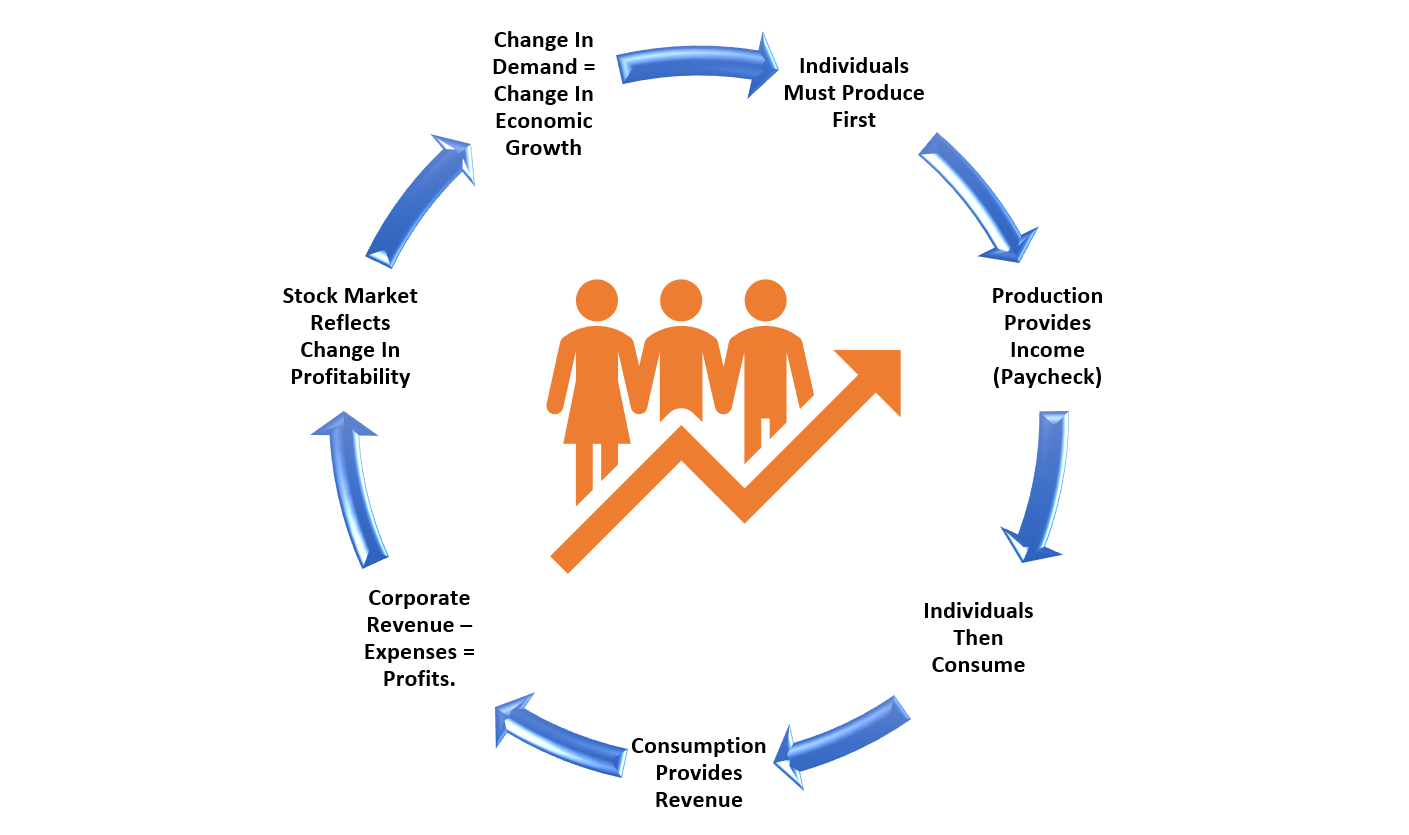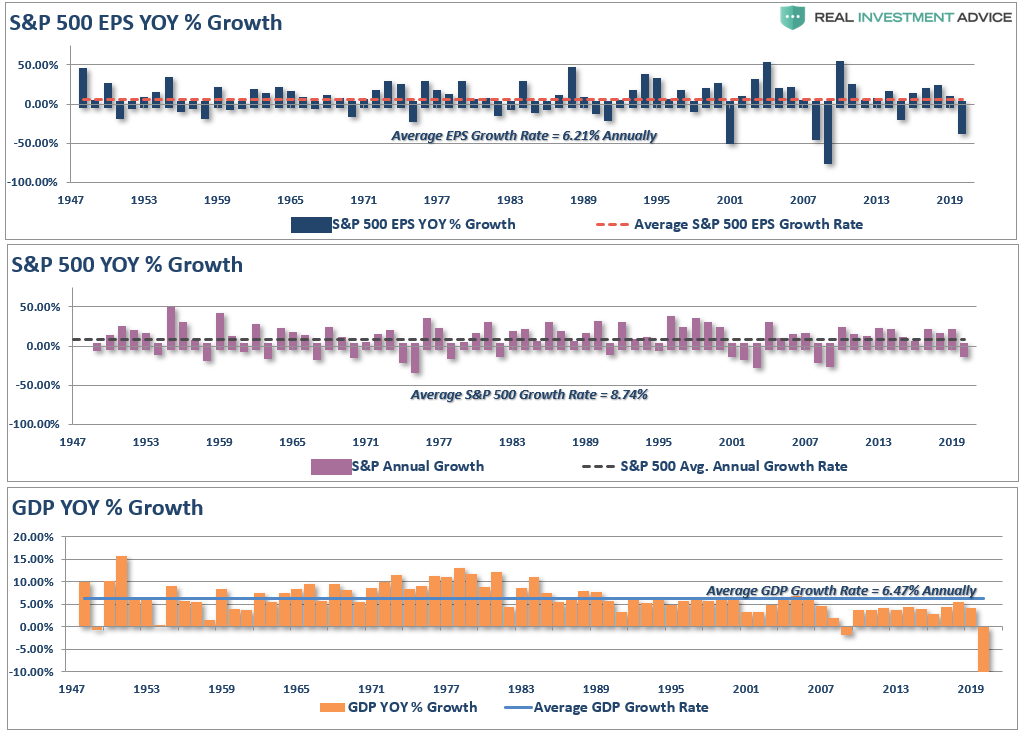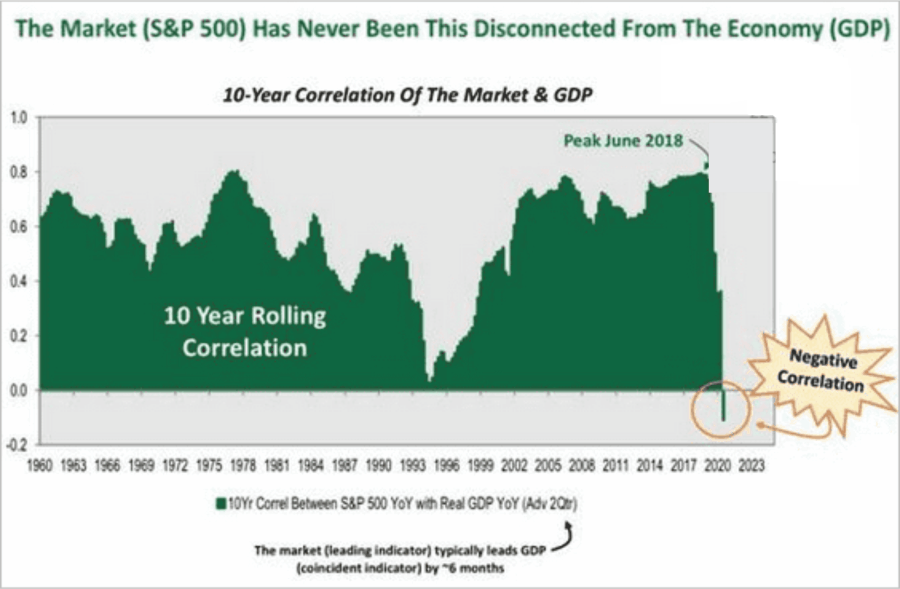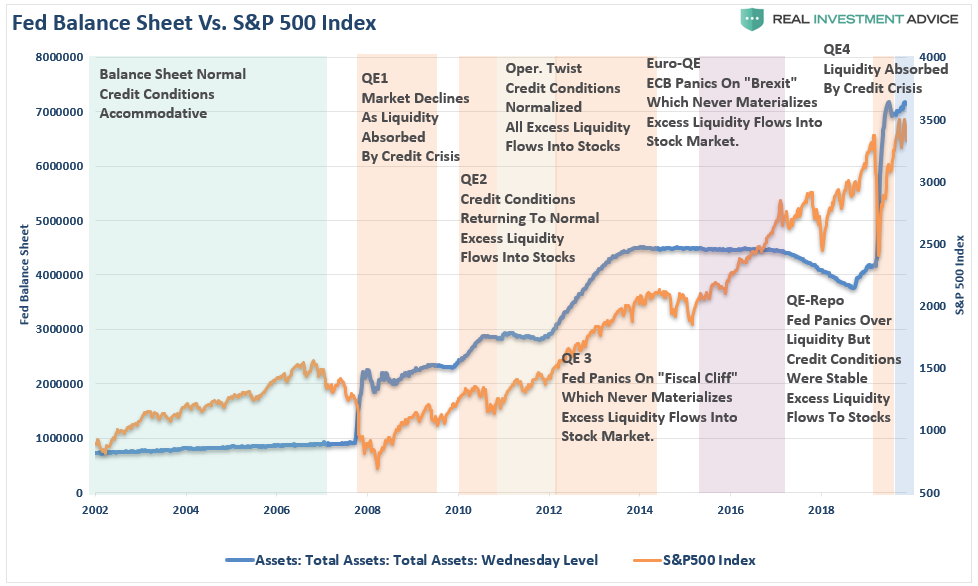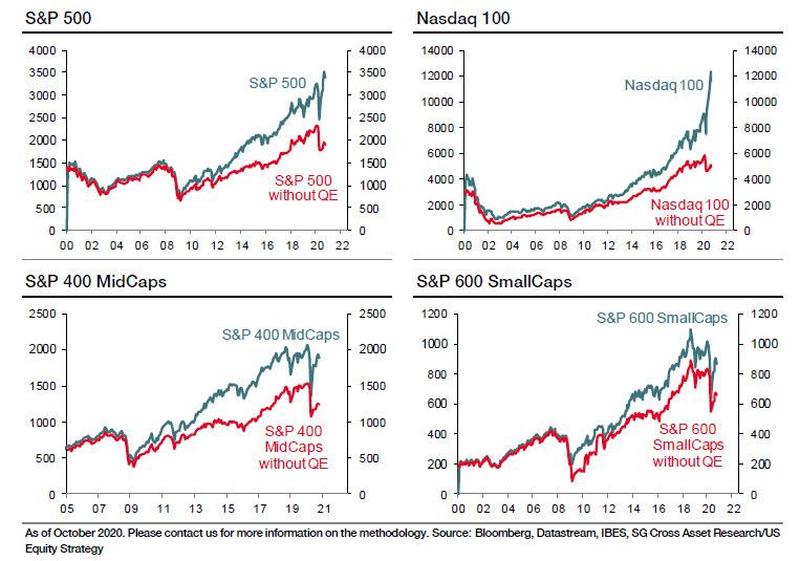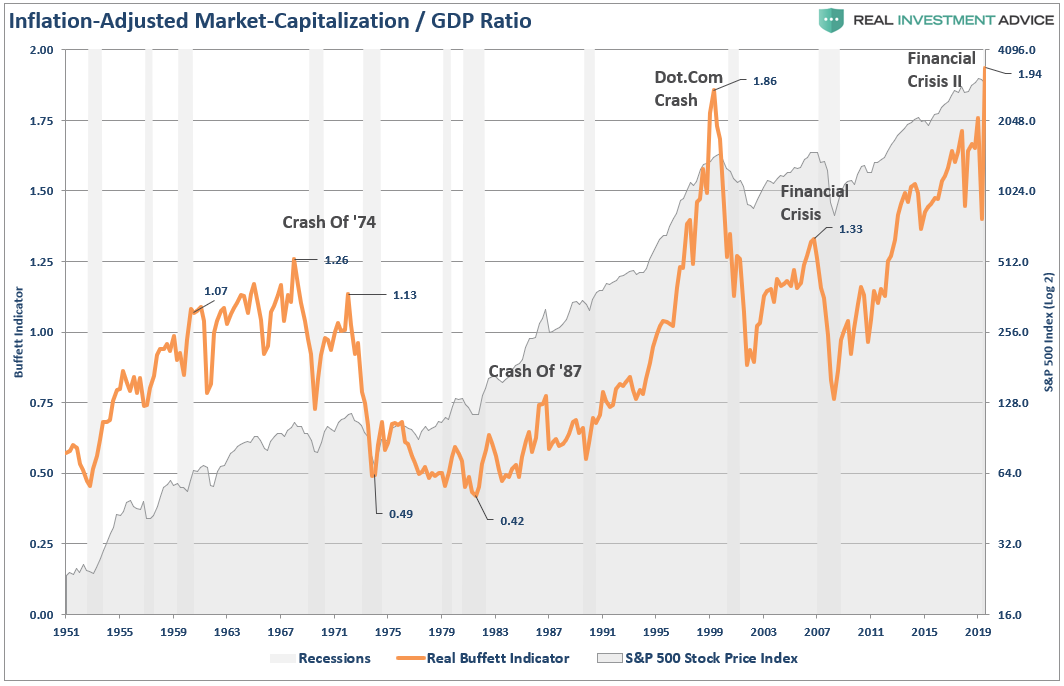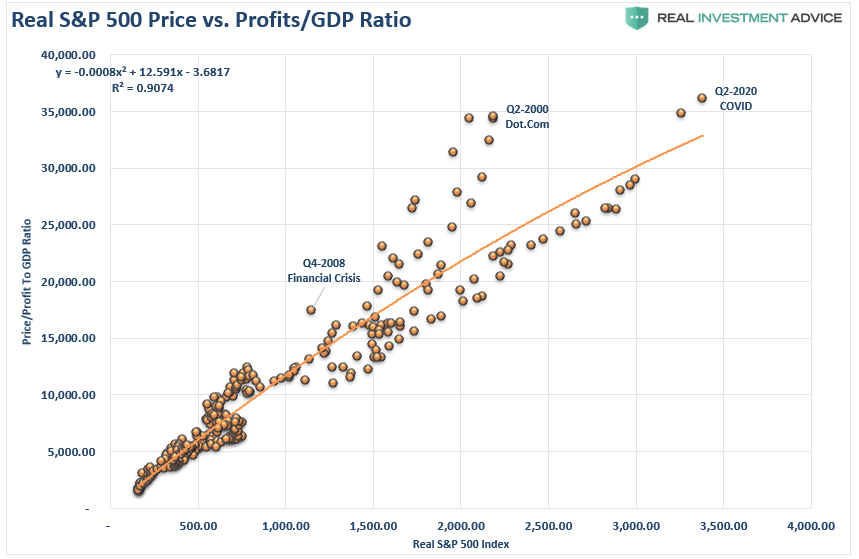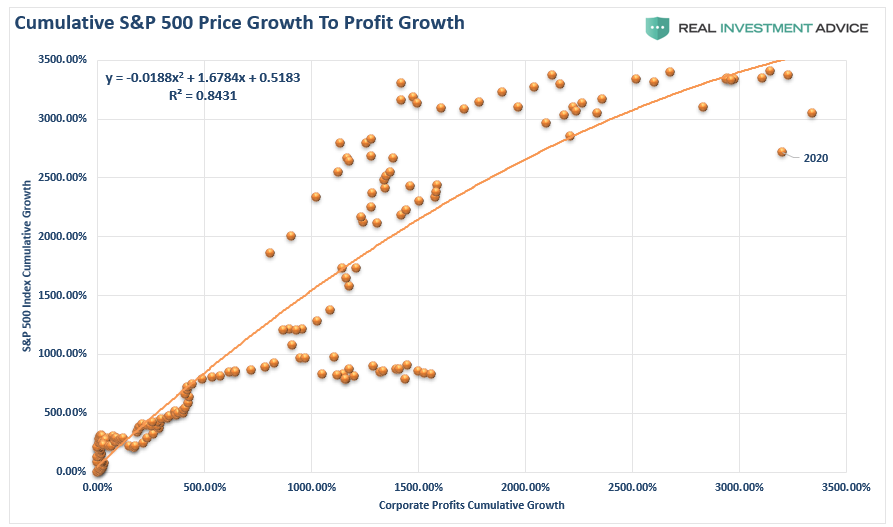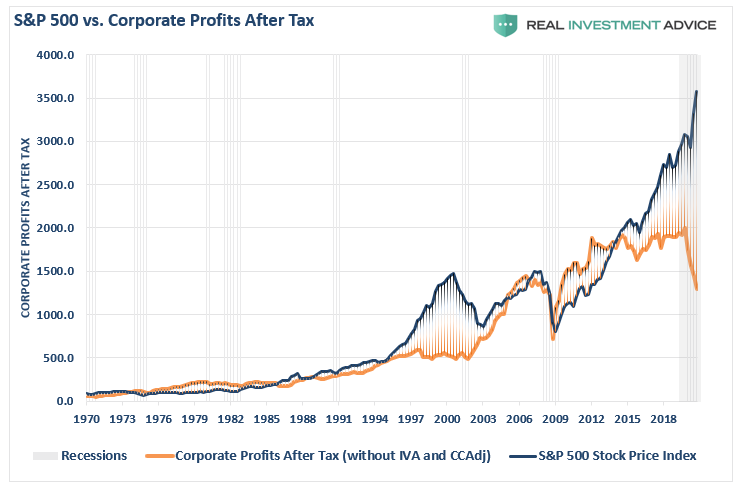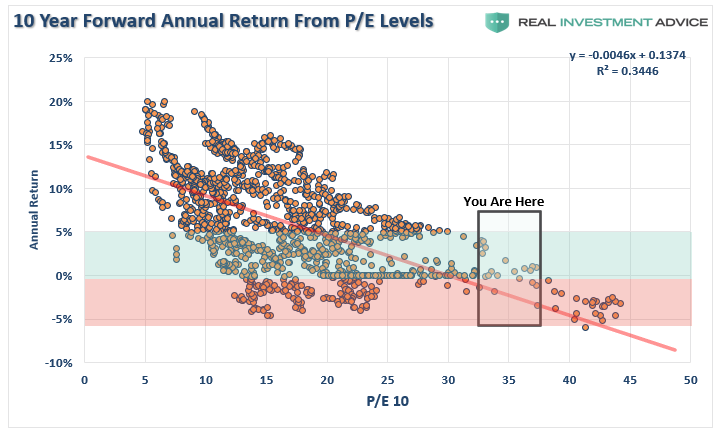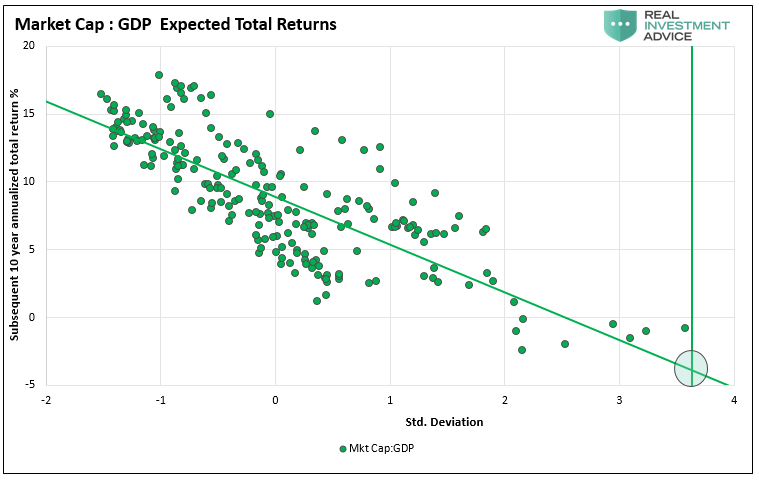by Lance Roberts, RIA
“The stock market is not the economy.” Such has been the “Siren’s Song” of investors over the last couple of years as valuation expansion has been the sole driver of the market’s performance. However, given that corporations derive their revenue from economic activity, the “Buffett Indicator” suggests investors may be walking into a trap.
Read Part 1 For More On This Chart
Understanding The Buffett Indicator
Many investors are quick to dismiss any measure of “valuation.” The reasoning is if there is not an immediate correlation, the indicator is wrong. As I discussed previously in “Shiller’s CAPE – Is It Just B.S.”
The problem is that valuation models are not, and were never meant to be, ‘market timing indicators.’ The vast majority of analysts assume that if a measure of valuation (P/E, P/S, P/B, etc.) reaches some specific level it means that:
- The market is about to crash, and;
- Investors should be in 100% cash.
Such is incorrect. Valuation measures are simply just that – a measure of current valuation. More, importantly, when valuations are excessive, it is a better measure of ‘investor psychology’ and a manifestation of the ‘greater fool theory.'”
What valuations do provide is a reasonable estimate of long-term investment returns. It is logical that if you overpay for a stream of future cash flows today, your future return will be low.
“Price is what you pay. Value is what you get.” – Warren Buffett
Such is what the Buffett Indicator tells us as it measures “Market Capitalization” to “GDP.” To understand the relative importance of the measure, we must understand the economic cycle.
The premise is that in an economy driven roughly 70% by consumption, individuals must produce to have a paycheck to consume. That consumption is where corporations derive their revenues and ultimately profits from. If something occurs, which leads to less production, the entire cycle reverses leading to an economic contraction.
The Historical Relationship
The example is simplistic, as many factors impact both the economy and markets short-term. However, there is a strong historical correlation between the market and the economy.
Since 1947, earnings per share have grown at 6.21% annually, while the economy expanded by 6.47% annually. That close relationship in growth rates should be logical. Such is particularly the case given the significant role spending has in the GDP equation. The chart shows the correlation between the two.
Given the historical data, the current “negative correlation” is quite an anomaly.
The Fed Impact
The break in the historical correlation has nothing to do with a change to market fundamentals. Instead, it is the Federal Reserve’s massive monetary interventions.
As Societe Generale recently noted, the distortion of market pricing from the economy is quite astronomical.
“Using the bank’s equity risk premium framework on the impact of QE…understand how the different US equity indices have been impacted since 2009. There is a huge dispersion among the equity indices under review. The Nasdaq 100 has been the most impacted, even more so this year. The S&P. 600 Small Caps, which has been the least impacted. As of Oct-2020, the Nasdaq 100 price level was 57% explained by QE.
Without QE the Nasdaq 100 should be closer to 5,000 than 11,000, while the S&P 500 should be closer to 1,800 rather than 3,300.”
The distortion of the financial markets by the Federal Reserve has created an illusion that the economy is doing exceedingly well when it reality it isn’t.
The Buffett Indicator
With this background, we now have a better understanding of what the “Buffett Indicator” represents as it measures “Market Capitalization” to “Gross Domestic Product.”
The indicator shows us that when “disconnects” between market participants and the underlying economy occur, a reversion ensues.
The correlation is more evident when looking at the market versus the ratio of corporate profits to GDP. With a 90% correlation, investors should not dismiss these deviations.
There is additional confirmation with an 84% correlation between the S&P 500 and corporate profits growth.
Since corporate profits are a function of economic growth, the correlation is not unexpected. Hence, neither should the impending reversion in both series.
The current detachment would not exist without the Fed’s largesse.
When it comes to the state of the market, corporate profits are the best indicator of economic strength. The detachment of the stock market from underlying profitability guarantees poor future outcomes for investors. But, as has always been the case, the markets can certainly seem to “remain irrational longer than logic would predict.”
However, such detachments never last indefinitely.
“Profit margins are probably the most mean-reverting series in finance. If profit margins do not mean-revert, then something has gone badly wrong with capitalism. If high profits do not attract competition, there is something wrong with the system, and it is not functioning properly.” – Jeremy Grantham
Valuations & Forward Returns
I previously quoted Cliff Asness on this issue in particular:
“Ten-year forward average returns fall nearly monotonically as starting Shiller P/E’s increase. Also, as starting Shiller P/E’s go up, worst cases get worse and best cases get weaker.
If today’s Shiller P/E is 22.2, and your long-term plan calls for a 10% nominal (or with today’s inflation about 7-8% real) return on the stock market, you are basically rooting for the absolute best case in history to play out again, and rooting for something drastically above the average case from these valuations.”
We can prove that by looking at forward 10-year total returns versus various levels of PE ratios historically.
Asness continues:
“It [Shiller’s CAPE] has very limited use for market timing (certainly on its own) and there is still great variability around its predictions over even decades. But, if you don’t lower your expectations when Shiller P/E’s are high without a good reason — and in my view, the critics have not provided a good reason this time around — I think you are making a mistake.”
And since we are discussing Mr. Buffett, let me remind you one of Warren’s more insightful quotes:
“Price is what you pay, value is what you get.”
The “Buffett Indicator” confirms Mr. Asness’ point.
Not surprisingly, like every other measure of valuation, forward return expectations are substantially lower over the next 10-years as opposed to the past 10-years.
Fundamentals Don’t Matter
I will agree with many that fundamentals don’t matter in the “heat of the moment.” As stated, they are poor timing indicators.
In a market where momentum is driving participants due to the “Fear Of Missing Out (FOMO),” fundamentals are displaced by emotional biases. Such is the nature of market cycles and one of the primary ingredients necessary to create the proper environment for an eventual reversion.
Notice, I said eventually.
As David Einhorn once stated:
“The bulls explain that traditional valuation metrics no longer apply to certain stocks. The longs are confident that everyone else who holds these stocks understands the dynamic and won’t sell either. With holders reluctant to sell, the stocks can only go up – seemingly to infinity and beyond. We have seen this before.
There was no catalyst that we know of that burst the dot-com bubble in March 2000, and we don’t have a particular catalyst in mind here. That said, the top will be the top, and it’s hard to predict when it will happen.”
Probably not.
James Montier summed it up perfectly in “Six Impossible Things Before Breakfast,”
“Current arguments as to why this time is different are cloaked in the economics of secular stagnation and standard finance workhorses like the equity risk premium model. Whilst these may lend a veneer of respectability to those dangerous words, taking arguments at face value without considering the evidence seems to me, at least, to be a common link with previous bubbles.“
Our Take
Stocks are far from cheap. Based on Buffett’s preferred valuation model and historical data, as depicted in the scatter graph below, return expectations for the next ten years are as likely to be negative as they were for the ten years following the late ’90s.
Read more on this graph from RIA PRO (30-Day Free Trial)
While investors insist the markets are currently NOT in a bubble, it would be wise to remember investors believed the same in 1999 and 2007. Throughout history, financial bubbles have only been recognized in hindsight when their existence becomes “apparently obvious” to everyone. Of course, by that point, it was far too late to be of any use to investors and the subsequent destruction of invested capital.
This time will not be different. Only the catalyst, magnitude, and duration will be.
Conclusion
Investors would do well to remember the words of the then-chairman of the Securities and Exchange Commission Arthur Levitt in a 1998 speech entitled “The Numbers Game:”
“While the temptations are great, and the pressures strong, illusions in numbers are only that—ephemeral, and ultimately self-destructive.”
There are a tremendous number of things that can go wrong in the months ahead. Such is particularly the case of a surging stock market against weakening fundamentals.
While investors cling to the “hope” that the Fed has everything under control, there is more than a reasonable chance they don’t.
Regardless, there is a straightforward truth.
“The stock market is NOT the economy.But the economy is a reflection of the very thing that supports higher asset prices – corporate profits.”
Copyright © RIA






